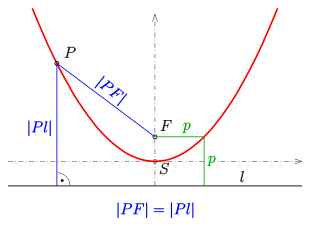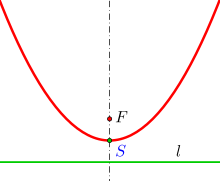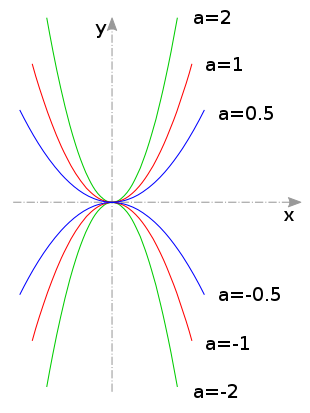Parabola
In mathematics, a parabola (via Latin parabola from ancient Greek παραβολή parabolḗ "juxtaposition, comparison, simile, equality"; traced back to παρά pará "next to" and βάλλειν bállein "to throw") is a second-order curve and is therefore describable via a second-degree algebraic equation. Along with the circle, the ellipse, and the hyperbola, it is one of the conic sections: it is formed when a straight circular cone intersects a plane that is parallel to a generatrix and does not pass through the apex of the cone. Because of this very special intersection requirement, the parabola plays a special role among the conic sections: it has only one focal point and all parabolas are similar to each other.
The parabola was discovered by Menaichmos and named parabolḗ by Apollonios of Perge (c. 262-190 BC).
Parabolas often appear in mathematics as graphs of quadratic functions .
Parables also play a role in daily life:
Definition with guideline
A parabola can be described geometrically as a locus line:
A parabola is the geometric locus of all points 



Noted as a point set:
The point midway between the focal point and the directrix is called the vertex 
If one introduces coordinates in such a way that 



of a parabola open at the top.
The half-width 




If we swap 

the equation of a parabola opened to the right.
Based on the definition, a parabola is the equidistance curve to its focal point and directrix.

Parabola: Definition with focal point F, directrix l (black) and half-parameter p (green). The perpendicular Pl and the distance PF (each blue) are the same length for all points P of the parabola (red).
Parabola as function graph
An upward or downward open parabola with vertex at zero (0,0) and the 
described. For 

- The focal point is
,
- the half-parameter is
,
- the directrix has the equation
and
- the tangent line at the point
has the equation
.
For 




After a shift the vertex shape of any upward or downward open parabola is 

Multiplying out gives the general equation of a parabola open down or up:
It is the graph of the quadratic function

Given the function 
Search within the encyclopedia












